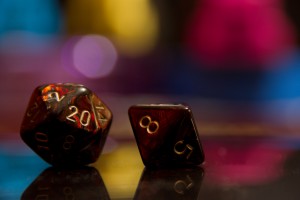Does Your Business Presentation Need a Strategy?
Growing up my friends obsessed over role-playing games. Dungeons and Dragons, War Hammer and a bunch of other games that I've blocked from memory. I never could get into these games, so I spent hours watching them play. Do you know what's geekier than playing Dungeons & Dragons? Being the D&D groupie.
These games were mostly about luck – rolling your 27-sided die and taking a chance. However, how you built your character was all strategy. To be a great warrior, you built your character a certain way. Want to be a great wizard – better up your magical skill. Strategy + luck = a fun game.
As adults, we aren't building characters (ok – some of us are), but building businesses. You have a marketing strategy, a social media strategy, a sales strategy and customer retention strategy. You get the point. There's a game plan for everything.
Except it seems for a big presentation where the formula is open PowerPoint + write slides + practice (maybe) = hope I don't bore the audience. The philosophy is to roll the 90-sided die and take your chances.
Table of Contents
Successful business presentations need a solid strategy
You've got a strategy for everything else so it makes sense before you open PowerPoint, type a single word or even start thinking about your outline that you understand the strategy for your pitch. If you don't have a game plan, the success of your presentation is solely based on luck.
Let's get crackin' and develop your strategy:
1. What's the opportunity?
It's business – you've got something to sell and someone who may be interested, so before we get into how to best serve that client – you need clarity around what's the opportunity of this presentation. It could be that it's just an introduction to your credentials and what you do for clients. It could be the client has a problem, and they want to see how your business solves their woes.
Understanding your opportunity insures that you don't go for the hard sell (which is going to make you look as sleazy as that Robin Thicke video) or you don't undersell and miss your opportunity to land a new client.
2. Who are these people?
You need to know everything you can about the people showing up to the pitch and their business. Who's showing up for your presentation? Who's their main competition? What's their big challenge? What's the challenge ahead in their industry? Who are the decision makers? What's their experience? What clients do they server? How would they like to expand their business?
Find out everything they can. Stalk them on LinkedIn, Google or Bing them (does anyone Bing it these days?)
Knowing their business and their industry and this helps you craft the message.
3. What experience do they have working with a business like yours?
Find out about their past history working with other businesses like yours. This is probably not their first go around, and if it is awesome…be their Jedi Knight. Do as much sleuthing as you can and if you read your client right – you might even been bold enough to ask. Let's say you're a copywriter, you might ask them “What do you like about your current copy? What do you wish could be different?” All valuable insight to have when crafting your message.
4. What value are you creating?
In the movie, Glengarry Glen Ross, Alec Baldwin told his salesman to “Alway be closing.” Hold your horses, Pitchy McPitchyenstein before you go for the close – know what value you want to create for your potential client. What can you give them for FREE during your presentation that they can implement immediately? What value are you creating for them?
You want them to buy, right? So why give insight away for free? You show that your helpful and that you care about their problem. You also invoke the most powerful tool of persuasion, reciprocity. When you give freely, people feel compelled to return the favor. You need to give in order to get the big sale.
5. What's your BIG IDEA?
The BIG IDEA is simply what you want your audience to leave the presentation with. What is the one thing you want them to know, feel or do after hearing your speech. This BIG IDEA guides everything in your presentation because everything you write leads to this goal.
It's the phrase that should be rolling off their lips after hearing you speak. It's what you want to be remembered for and ties closely to #4. It's the most important statement to craft in your entire presentation. Don't type a word until your clear on your BIG IDEA.
Do not leave your big pitch up to chance. It's your business not a rousing game of D&D.
Now, you take all of this research – all of this knowledge – and craft your message. The key is to develop absolute empathy with your audience and find the message that resonates.
Need help developing and implementing your strategy? Work with me to develop that game plan to make sure you next presentation hits the mark and gets in your prospective client's heart.


[…] presentation needs a strategy. Santa couldn’t deliver toys in a single night if he didn’t have a game plan to get it […]